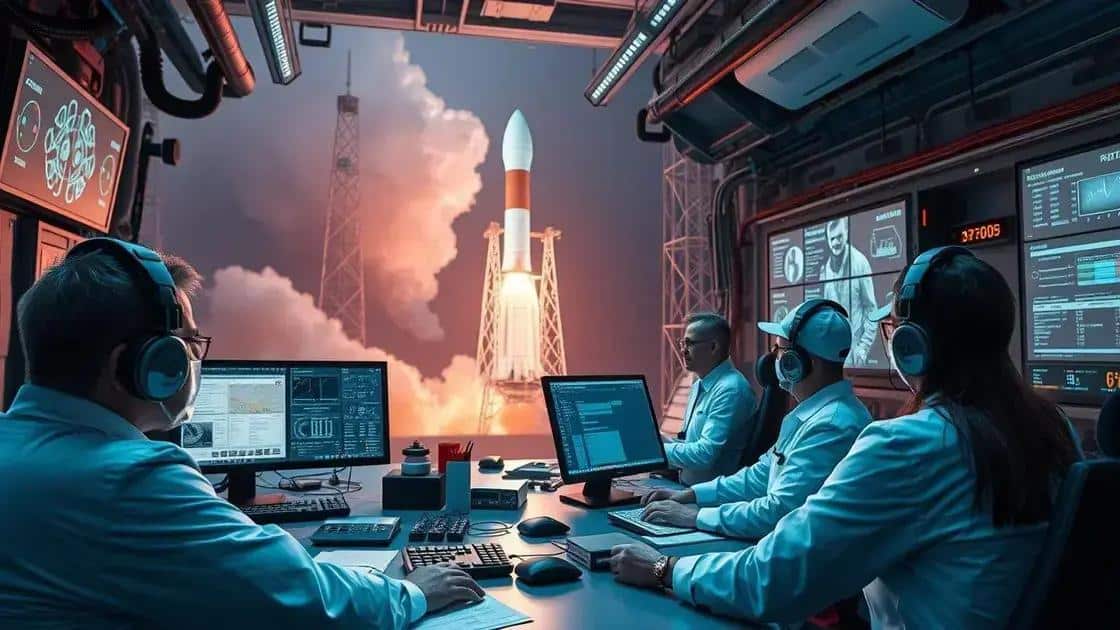Updates on international space exploration: what’s new?

International space exploration involves collaboration among countries and private companies, leveraging emerging technologies to conduct missions, uncover cosmic mysteries, and inspire future generations through advancements in science and research.
Updates on international space exploration show how fast-paced and dynamic this field is becoming. With advancements in technology and collaboration between countries, it’s a thrilling time for space enthusiasts. Have you ever wondered what groundbreaking discoveries are just around the corner?
Recent milestones in global space missions
Recent milestones in global space missions highlight the incredible achievements and advancements made by nations around the world. As technology evolves, we see a plethora of exciting developments that push the boundaries of space exploration.
Breakthrough Launches
This year, several countries have successfully launched missions that mark significant progress in space exploration. Notable launches include:
- The first crewed mission to the moon in over 50 years.
- International Mars exploration projects involving multiple nations.
- Launches of new telescopes aimed at uncovering the secrets of the universe.
These successful launches not only demonstrate technological capability but also foster international cooperation in space exploration.
Innovative Technologies
The introduction of innovative technologies has been critical in achieving these milestones. For instance, reusable rocket technology has revolutionized the way we think about launching spacecraft. This has resulted in:
- Significantly lower costs for launching missions.
- The ability to send more frequent missions into space.
- Increased sustainability in space travel.
Such advancements make space more accessible, encouraging even smaller nations to participate in global space initiatives.
Moreover, collaboration among various space agencies has led to shared resources and expertise. By working together, countries can tackle the complex challenges associated with space missions.
The successful deployment of satellites for global communication and environmental monitoring also showcases the benefits of international collaboration. These satellites are helping us to better understand climate change and can be pivotal in disaster response.
Overall, the journey of recent milestones in global space missions reveals how far we’ve come and the exciting future that lies ahead in space exploration.
Notable international collaborations in space exploration
Notable international collaborations in space exploration have transformed how countries work together to achieve shared goals. These partnerships enhance our capabilities and pave the way for groundbreaking discoveries.
Key Collaborations
Several significant collaborations have emerged in recent years. These include:
- The International Space Station (ISS), a joint effort involving NASA, ESA, Roscosmos, JAXA, and CSA.
- The Mars Exploration Program, which includes contributions from NASA, ESA, and various international scientific institutions.
- Joint satellite missions that focus on climate monitoring and space observation.
Such collaborations have led to a greater understanding of our universe and increased the efficiency of missions.
Benefits of International Cooperation
International cooperation in space missions brings numerous advantages. It allows for:
- Sharing of knowledge and expertise between nations.
- Pooling of financial resources to fund ambitious projects.
- Development of new technologies that benefit all partners involved.
By working together, countries can overcome challenges that would be difficult to face alone. This collaborative spirit is a crucial driver of innovation in the field of space exploration.
Additionally, international partnerships foster peaceful relations between nations. As countries unite for common purposes, they build trust and camaraderie, which can lead to stability beyond space initiatives. The knowledge gained from collaboration also promotes scientific advancement for all humanity.
Looking ahead, the future of international collaboration in space exploration seems promising. New missions are being planned, with more nations expressing interest in participating. This trend signals a more unified approach to exploring space and solving global challenges through scientific inquiry.
The role of private companies in space initiatives

The role of private companies in space initiatives has become increasingly significant in recent years. These companies are driving innovation and expanding the possibilities of exploration beyond traditional government-led programs.
Emergence of Commercial Spaceflight
With the rise of commercial spaceflight, we see various companies like SpaceX, Blue Origin, and Virgin Galactic at the forefront. These firms have pioneered new technologies that make space travel more accessible.
- SpaceX’s Falcon rockets have revolutionized launch costs.
- Blue Origin is focused on developing reusable rocket systems.
- Virgin Galactic is working on suborbital flights for space tourism.
This trend has made it possible for more entities to participate in space exploration.
Collaboration with Governments
Private companies are not just competing with government agencies; many are collaborating with them. Partnerships between the public and private sectors are becoming common.
- NASA has contracted companies for resupply missions to the ISS.
- Collaborative projects are fostering advancements in technology.
- Joint missions, such as the Artemis program, benefit from private innovation.
These alliances help both sides leverage their strengths for ambitious goals.
Moreover, the contributions of private companies extend beyond logistics. They are also involved in research and development, helping to push the boundaries of knowledge in space science. The use of private funding allows for faster project execution and increased flexibility.
As more private companies enter the space arena, we can expect a shift in how missions are planned and executed. This new landscape promises to diversify opportunities for discovery and exploration, allowing for exciting advancements.
Emerging technologies driving space research
Emerging technologies are playing a vital role in driving space research forward. These innovations are making it easier and more efficient to explore the universe and gather crucial data.
Advanced Robotics
Robotics technology is essential in space exploration. Robots are being used for various tasks, including:
- Conducting repairs and maintenance on spacecraft.
- Gathering samples on other planets and moons.
- Performing complex maneuvers that human astronauts cannot.
This technology enhances our ability to investigate environments that are too dangerous for humans.
Artificial Intelligence
Artificial intelligence (AI) is revolutionizing how we analyze vast amounts of data. AI algorithms can:
- Process information from space missions far quicker than human analysts.
- Identify patterns and anomalies in data that visibility might miss.
- Assist in navigation and maneuvering of spacecraft during missions.
AI enables researchers to make informed decisions based on real-time data.
Moreover, sensors and imaging technologies have improved drastically, allowing us to gather information about distant planets and celestial bodies. High-resolution images help scientists make more accurate assessments about the composition and conditions of these places. Advanced telescopes, equipped with state-of-the-art sensors, can now detect exoplanets and analyze their atmospheres.
Innovations in propulsion systems are also significant. New technologies are being developed to improve fuel efficiency and reduce travel time. This includes the use of ion propulsion and solar sails, which can expand the reach of our missions beyond traditional limits.
Collectively, these emerging technologies in space research create exciting opportunities for the future. They not only enhance our capabilities but also push the boundaries of what we can achieve in the quest to understand the cosmos.
Future prospects for international space exploration
Future prospects for international space exploration hold great promise as countries around the world continue to collaborate and invest in their space programs. As technology advances, the possibilities become more exciting.
Upcoming Missions
Several upcoming missions are set to explore the moon and Mars, among other targets. These missions will:
- Focus on sustainable lunar exploration through NASA’s Artemis program.
- Search for signs of life and study the geology of Mars with coordinated efforts from NASA and ESA.
- Launch missions to asteroids to understand their composition and potential resources.
Such missions not only aim to expand our scientific knowledge but also foster global partnerships.
Increased Participation of Nations
More countries are investing in their own space initiatives. Nations like India, the UAE, and Australia have shown interest in launching their own spacecraft. They are motivated by:
- The desire to contribute to scientific knowledge.
- The hope of inspiring future generations in STEM fields.
- The potential economic benefits from satellite technologies.
As emerging space-faring nations continue to join the community, the landscape of international cooperation will evolve.
Moreover, the role of private companies is expected to grow in the coming years. As commercial spaceflight becomes more common, private enterprises can help offset costs and facilitate missions. They can partner with national agencies to expand objectives and increase the frequency of launches.
Technological advancements in areas such as propulsion, robotics, and artificial intelligence will also impact future explorations. These technologies promise to make missions safer, faster, and more efficient. Innovations will allow us to tackle challenges that arise in space and ensure successful missions.
In summary, the prospects for international space exploration are geared toward a collaborative and science-driven future, with numerous exciting projects on the horizon.
As we look to the future of international space exploration, it is clear that collaboration and innovation will play key roles. With emerging technologies and increased participation from countries worldwide, we are on the brink of exciting discoveries. Private companies, alongside government agencies, will push the boundaries of what is possible in space travel and research. This unified effort promises to unleash new knowledge, foster global partnerships, and inspire generations to come. Together, we’ll uncover the mysteries of the cosmos and expand humanity’s reach beyond our planet.
FAQ – Frequently Asked Questions about International Space Exploration
What role do private companies play in space exploration?
Private companies are becoming key players by providing innovative technologies, reducing costs, and partnering with government agencies for various missions.
How is international collaboration impacting space research?
International collaboration enables countries to share resources and expertise, leading to more ambitious projects and greater discoveries.
What emerging technologies are driving future space missions?
Emerging technologies like advanced robotics, artificial intelligence, and improved propulsion systems are enhancing safety, efficiency, and capabilities of space exploration.
What can we expect in the future of international space exploration?
The future will likely see increased global participation, more frequent missions, exciting discoveries, and a greater focus on sustainable exploration of the moon and beyond.





